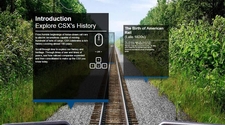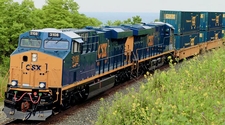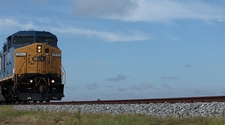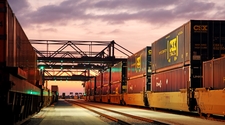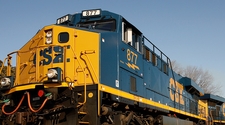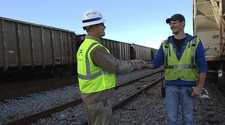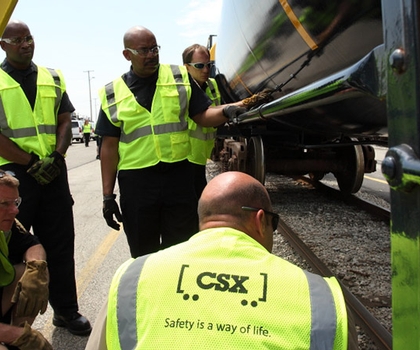Safety is always CSX’s first priority, and every decision we make is intended to move the freight entrusted to us from origin to destination without incident. For many years, CSX has been a leader in assembling an expert team to manage hazardous materials movements and to respond to hazardous materials incidents. Today, the CSX chemical safety and hazardous materials teams work closely with customers and local communities to train for and safely manage the movement of hazardous materials.
Information Sharing and Training
CSX routinely provides detailed information about the cargo we carry and the routes we use to the state and local first-responder organizations that are responsible for protecting the public’s safety in the event of a railroad incident. We have done this voluntary and in compliance with all federal regulations governing the transport of hazardous materials, and we will continue to do as part of our commitment to the safety of our employees and the community where we operate.
We share information with first responders, community emergency planners and state and federal officials in several ways:
- Upon request, we provide density studies to first responders and state and federal officials that identify an annual rank listing by volume of the hazardous materials that we carry through a given community and the quantities we move, so first responders have an understanding of the likelihood of encountering any given type of material in an incident.
-
In addition, the availability of the rail industry’s mobile tool, AskRail, that first responders can use to securely access information about hazardous materials being transported by any individual CSX train. First responders’ ability to quickly understand the contents of rail cars supports an effective response that protects both the local communities and first responders themselves. CSX recognized the need for responders to more easily access this critical information and developed a mobile application that would share that critical information in a user-friendly, easily-accessible format. This gives them access to critical information while they are en route or on the scene of an incident involving a CSX train. In the event of an incident, first responders who arrive on scene can use the alpha numeric code displayed on the side of any rail car to look up the information about that car – what’s in it, how the product behaves, any exposure considerations, and contact information for all of the Class I railroads to immediately reach the right person on the phone. The system also includes schematics for tank cars and Amtrak coach cars, a virtual damage assessment tool and a list of the top 25 hazardous materials shipped by CSX. In addition, advanced users, typically on-scene incident commanders, will also be able to request the entire CSX train consist on demand, without having to contact the railroad.
In addition, our Community Emergency Response Guide, which we periodically send out to fire departments and other first responders over our entire system, includes planning tips for responding organizations and has long listed the top hazardous materials commodities transported by U.S. railroads and those transported by CSX.
Each year CSX conducts a variety of training for first responders throughout the network to help strengthen CSX’s partnerships and provide a higher level of emergency response readiness. This training includes hands-on sessions, classroom training at local fire stations, exercises and table-top drills and the Responder Incident Training (RIT) train. For example, in 2022, CSX committed over 2,900 hours training more than 3,600 first responders during 40 training events in 35 cities. In addition, CSX provides access to web-based and self-study training courses for first responders each year. In 2022 alone, CSX trained or provided access to training for approximately 800 emergency first responders.
Operating Procedures
CSX’s hazardous material transportation procedures are regulated by several federal organizations including the U.S. Department of Transportation, U.S. Transportation Security Administration, and U.S. Environmental Protection Agency, as well as by industry best practices.
State and local emergency response agencies also regulate our procedures for hazardous material shipments.
CSX operating procedures include special rules for handling hazardous materials, which require that specific activities and precautions are taken when moving these materials. In addition, the CSX Public Safety and Environment Management System maintains a series of documents that provide detailed instructions about performing public safety and environmental tasks as they relate to the responsible transport or clean-up of hazardous materials. CSX guidelines complement the Association of American Railroads’ published standards of operating practices for the transportation of hazardous materials (Circular No. OT-55).
In the event of an emergency involving a hazardous material, CSX employees are well prepared to respond quickly and in a way that protects public safety and the environment. In addition to regular training programs for state and local first responders and Emergency Management Agencies, a series of emergency response plans document appropriate rail emergency response procedures and notifications.
Validation
CSX continually conducts inspections of hazardous material shipments to ensure the safety of our employees, our customers’ freight and the communities we serve.
CSX conducts hazardous materials inspections in major rail yards each year. These inspections include in-depth reviews called Hazmat Confident Campaigns, which involve a large team of hazardous materials professionals, as well as smaller, more frequent yard inspections conducted by local CSX Hazardous Materials Managers. Both types of reviews involve a detailed inspection of CSX trains, customer railcars, including shipment documentation, and employee actions for compliance with U.S. Department of Transportation regulations related to hazardous materials.
The CSX Internal Audit process verifies our train inspection procedures, including our efforts to track safety operations as related to hazardous materials shipment. Yard emergency response plans are reviewed by CSX Hazardous Materials Managers on a regular basis.


